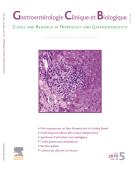Overlap syndrome of primary biliary cirrhosis and autoimmune hepatitis: a retrospective study of 115 cases of autoimmune liver disease - 23/04/08

Summary |
Objective |
The aim of this retrospective study was to compare clinical, biological, and histological features and treatment response in 115 patients with overlap syndrome (OS), autoimmune hepatitis (AIH) or primary biliary cirrhosis (PBC).
Methods |
Consecutive patients with AIH, PBC or OS followed between 1984 and 2005 in five different centers were included. All data were re-evaluated using current diagnostic criteria of each disease.
Results |
Fifteen patients had OS (13 females), 48 AIH (40 females) and 52 PBC (49 females). Patients with OS were significantly younger than patients with PBC (median age: 44 vs 59 years). Jaundice (20%) and pruritus (20%) were the main initial symptoms in OS. Patients with OS had serum transaminase and γ globulin levels significantly higher than patients with PBC; serum alkaline phosphatase, gamma-glutamyl-transpeptidase and IgM levels were significantly higher in OS than in patients with AIH. Histological analysis showed moderate or severe piecemeal necrosis in 86% and destructive cholangitis in 93% in OS group. Among 11 patients with OS treated with ursodeoxycholic acid (UDCA) or immunosuppressors alone, only 6 had a complete biochemical response. In contrast, all patients with OS receiving combined therapy, as first or second line, responded, 5 patients to the combination corticoste-roids-azathioprine-UDCA and 2 to the combination cyclosporine-UDCA.
Conclusion |
OS is not rare and accounts for 13.9% of patients with autoimmune liver disease in our series. Combination of immunosuppressors and UDCA appears the most efficient treatment in these patients.
Il testo completo di questo articolo è disponibile in PDF.Résumé |
Buts |
L’objectif de cette étude rétrospective était de comparer les caractéristiques cliniques, biologiques et histologiques ainsi que la réponse aux traitements de 115 malades atteints d’un syndrome de chevauchement (SC), d’une hépatite auto-immune (HAI) ou d’une cirrhose biliaire primitive (CBP).
Méthodes |
Ont été inclus les malades atteints d’HAI, de CBP ou de SC pris en charge entre 1984 et 2005 dans cinq centres de Champagne-Ardenne. Tous les dossiers ont été réévalués selon les critères diagnostiques actuels de chaque maladie.
Résultats |
Quinze malades étaient atteints d’un SC (13 femmes), 48 d’une HAI (40femmes) et 52 d’une CBP (49 femmes). Le groupe SC était significativement plus jeune que le groupe CBP (âge médian : 44 vs 59 ans). L’ictère (20 %) et le prurit (20 %) étaient les principaux signes cliniques inauguraux du SC. Les malades ayant un SC avaient une activité sérique des transaminases et des taux de γ-globulines significativement plus élevés que ceux ayant une CBP et une activité des phosphatases alcalines, de gammaglutamyltranspeptidase et un taux d’IgM plus élevés que ceux ayant une HAI. Dans le groupe SC, l’analyse histologique montrait une nécrose parcellaire modérée ou sévère dans 86 % et une cholangite destructrice dans 93 % des cas. Parmi les 11 malades traités par l’acide ursodésoxycholique (AUDC) ou des immunosuppresseurs en monothérapie, seulement 6 ont eu une réponse biochimique complète. En revanche, tous les malades recevant un traitement combiné, en première ou seconde intention, ont été répondeurs : 5 à l’association corticoïdes-azathioprine-AUDC, et 2 à l’association ciclosporine-AUDC.
Conclusion |
Le SC n’est pas rare, représentant 13,9 % des hépatopathies auto-immunes dans notre série. L’association immunosuppresseurs-AUDC apparaît comme le traitement le plus efficace chez ces malades.
Il testo completo di questo articolo è disponibile in PDF.Mappa
Vol 31 - N° 1
P. 17-25 - Gennaio 2007 Ritorno al numeroBenvenuto su EM|consulte, il riferimento dei professionisti della salute.

